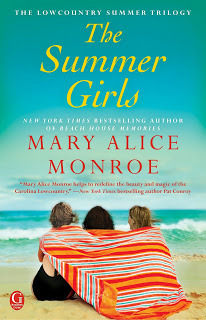Are you like me after reading a really good book—wondering to yourself what sparked the idea behind the author’s story? Memorable characters, suspenseful scenarios, unforgettable dialogue…I try to imagine what real-life experiences or observations in that writer’s life might have led to such a well-told story that kept me interested from cover to cover.

I just returned home from a whirlwind book tour that has me both exhausted and exhilarated. Exhausted because I’ve been on the road since the week before
THE SUMMER GIRLS debut. Exhilarated because I've received such amazing support and comments from readers and booksellers. Thanks to all of you, this novel, book one of
The Lowcountry Summer Trilogy, hit the main New York Times Best Sellers list.
During the book signings, reading events and luncheons, readers often asked what was the spark behind THE SUMMER GIRLS? As I’ve mentioned in a previous post (
Why Dolphins, Why Now
), my style of writing weaves together the characters’ lives from my story world with the animals of our real world. Nature is the inspiration for my novels. I’ve long dreamed of writing about the bottlenose dolphins I often see here in the Lowcountry but the moment was just never right. I hadn’t received a sign from above to write the novel; that is until one particular day at the South Carolina Aquarium.
While serving as a member of the board of directors, we were called together at the aquarium for an important meeting led by Philippe Cousteau—explorer, environmental activist and grandson of the famous Jacques Cousteau. He was giving a special presentation about dolphins. Coincidently, I had just watched a soul-stirring documentary on dolphin captivity in Japan called The Cove (an eye-opening, must-see film). With Philippe were Dr. Stephen McCulloch of the Marine Mammal Research and Conservation program at Florida Atlantic Universityand Dr. Pat Fair, head of marine mammal studies at the Charleston branch of NOAA (National Oceanic and Atmospheric Administration). They informed us that 48%--almost half--of the dolphins living in Charleston's estuarine waters were sick. And 52% in Florida's estuarine waters. I was shocked, as I'm sure you are, too. It was during that meeting Philippe and Pat told me that it’s time to write the book about dolphins--now. They understood how my novels can reach a wide range of readers, people who might not pick up a non-fiction article or book about dolphins.
I dove first into academic research, learning everything I could about the Atlantic bottlenose dolphin, the type of dolphin found in our waters. I also began Photo IDs of our resident dolphins with Dr. Pat Fair. Pat has since become my mentor in my research and a friend. We zipped along the waterways in NOAA's Zodiac boat, stopping whenever a dolphin was sighted. Photographs are taken of the dorsal fin. These have unique markings similar to our fingerprints. The photos are then analyzed in the computers, dolphins identified, and the community health status observed.
Next I journeyed to the Florida Keys to volunteer at the Dolphin Research Center. For several weeks I did whatever dirty job they asked me to do, slowly moving my way up the ladder to involvement with the dolphins. I learned that dolphins are not only social and highly intelligent creatures, but that they have huge personalities. The second year's visit I volunteered in the Pathways program with a boy with special needs, and the Oddyssey program with wounded warriors. I'll write more about these powerful experiences later.
During the many months of reading about, observing and working with the species, my story world opens up. Characters take shape. Plot develops. Themes crystalize. Everything starts coming together. The dolphins taught me three major lessons:
1) the power of communication
2) the importance of family and community bonds
3) to remember to laugh.
From these lessons I created themes, then plot and characters. Of the characters, there are two strong females, parallels that seam all three books together--Mamaw, the Muir grandmother and Delphine, the charismatic dolphin.
THE SUMMER GIRLS isn’t
about the bottlenose dolphin though. It’s about three sisters, disconnected, unable to communicate and searching for their identities, brought together by their scheming grandmother, Mamaw, on hopes they will rediscover the bonds of family. During a three-month stay at Mamaw’s Sea Breeze beach house, the women find their lifeline in a wild dolphin .
Little did I know that Philippe’s push to write the dolphin book I’d been dreaming of would become a trilogy! And that leads me to the most frequently asked question I’ve been getting on tour, through my website and on Facebook—when’s the next installment coming out?
The answer is…June 2014, my friends!
Thank you for the massive support of
THE SUMMER GIRLS, book one of
The Lowcountry Summer Trilogy. I'm already working on book two . I can’t wait to share more with you about the Muir girls and the beguiling dolphin, Delphine.
What did you find most interesting about the bottlenose dolphin in the novel? What questions do you hope will be answered in the sequel?
 newest »
newest »
 newest »
newest »
 I have read many of your books and would like to comment on the plight of the bottle nose dolphin in the Indian River Lagoon. We are friends of the Harbor Branch Oceanographic Institute. We are very familiar with the research done there in regard to the marine life in the lagoon. Also we are aware of the amount of illness and untimely deaths of some of our precious sea life. Just recently the Army corp of engineers released chemical and debris from Lake Okeechobee into the St. Lucie River. It was diverted this way to protect the profits of the sugar cane farmers who are more interested in profits than in the state of the environment and our sea life. within days the waters became murky and had an odor. Our governor is also influenced by these big profit institutions and vetoes most legislation that affects the well fair of animals and plants in this area. In addition to the loss of sea life, we have also lost most of our sea grass where young fish are hatched and live until they are mature enough to live in the wild. This is due to propellers from pleasure boats and frequent algae blooms. The area is very stressed and the animals are suffering. We have circulated petitions and are connected with local concerned citizens but we are grateful for authors such as yourself who are willing to reach a larger audience. We have only one environment to live in and we must protect it or we will have no place to live or survive. We can't feed people, animals or plants in a polluted environment no matter how much money a country makes. We need a clean healthy environment and change seems to have to come from grass roots communities.
I have read many of your books and would like to comment on the plight of the bottle nose dolphin in the Indian River Lagoon. We are friends of the Harbor Branch Oceanographic Institute. We are very familiar with the research done there in regard to the marine life in the lagoon. Also we are aware of the amount of illness and untimely deaths of some of our precious sea life. Just recently the Army corp of engineers released chemical and debris from Lake Okeechobee into the St. Lucie River. It was diverted this way to protect the profits of the sugar cane farmers who are more interested in profits than in the state of the environment and our sea life. within days the waters became murky and had an odor. Our governor is also influenced by these big profit institutions and vetoes most legislation that affects the well fair of animals and plants in this area. In addition to the loss of sea life, we have also lost most of our sea grass where young fish are hatched and live until they are mature enough to live in the wild. This is due to propellers from pleasure boats and frequent algae blooms. The area is very stressed and the animals are suffering. We have circulated petitions and are connected with local concerned citizens but we are grateful for authors such as yourself who are willing to reach a larger audience. We have only one environment to live in and we must protect it or we will have no place to live or survive. We can't feed people, animals or plants in a polluted environment no matter how much money a country makes. We need a clean healthy environment and change seems to have to come from grass roots communities.




